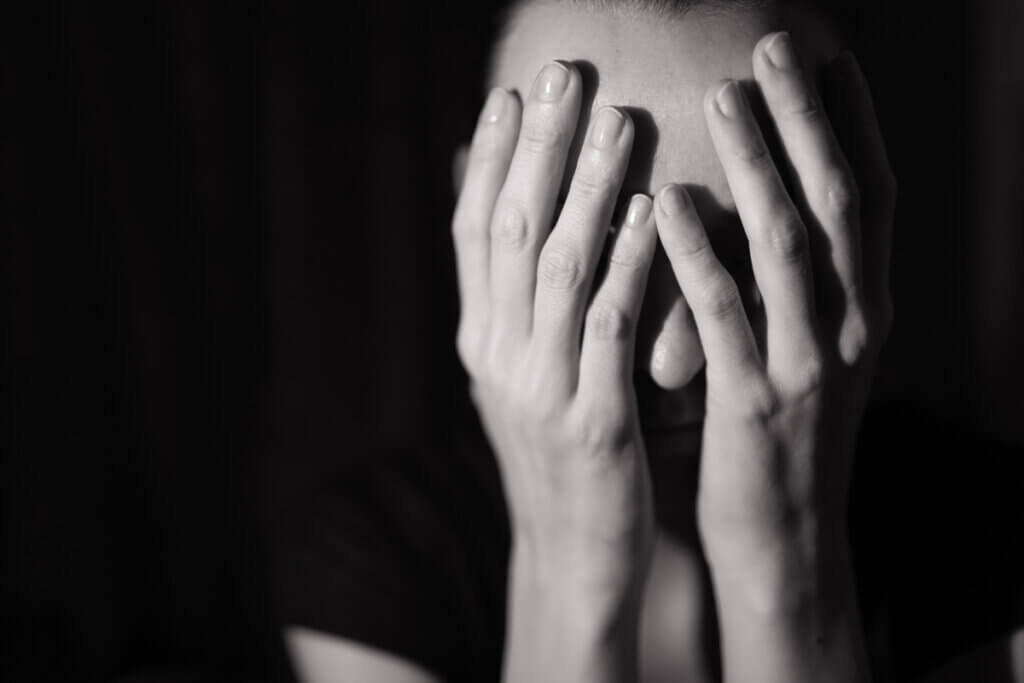Algophobia: Irrational Fear of Pain

Algophobia is a circumscribed anxiety disorder. It’s included in the category of specific phobias that are characterized by the manifestation of an irrational, excessive, unjustified and uncontrollable fear of pain. In fact, people with this disorder fear feeling or experiencing any kind of painful sensation.
Being afraid of experiencing pain isn’t exactly a disorder. Indeed, we all, to a certain extent, flee from pain. That’s because it’s not a pleasant sensation, even though it’s a basic instinctual response that warns you that you’re suffering some kind of damage to your body.
You might ask when fear of pain becomes a disorder. It’s when it begins to affect the life of the person on a social, personal, work, or family level. When the fear that the person develops is so intense that they’ll avoid doing any activity or even moving for fear of suffering an accident that’ll cause them pain. It’s a fear that ends up directly affecting their quality of life.
Characteristics of phobias
According to Capafóns (2001) the characteristics of phobias that differentiate them from non-pathological fear are the following:
- The fear is completely disproportionate.
- The individual can’t explain it.
- It’s beyond their voluntary control.
- It leads to avoidance of the feared situation or object.
- It persists over time.
- It’s maladaptive.
- It isn’t specific to a certain stage or age.

Symptoms of algophobia
Some of the symptoms of algophobia, according to Sosa and Capafóns (2014), are the following:
- Increased heart rate.
- Increased respiratory rate.
- Sweating.
- Stomach contractions.
- Elevated blood pressure.
- Negative self-verbalizations.
- Negative beliefs.
- Intrusive thoughts.
- Worries.
- State of alarm.
The above symptoms fall into two categories: physiological and cognitive. Physiological manifestations directly trigger a good part of the physical and organic responses of the individual. On the other hand, the cognitive expression of phobia is characterized by the set of ideas, thoughts, or beliefs that the person possesses in relation to pain.
Within the classification of the symptoms of phobias, we can also find the behavioral responses that the person displays to face the feared situation. The most common reactions are avoidance or escape behaviors.
Usually, the person suffering from a phobia will adopt these kinds of responses because they provide relief. However, in reality, it’s only a temporary relief, as the problem persists.
Causes of algophobia
One of the main explanations for the cause of algophobia is that of classical conditioning. From this perspective, it’s assumed that the phobia is the result of the sufferer having experienced a past traumatic situation related to pain. In the case of algophobia, the person must’ve suffered exceptionally intense pain, because, in effect, it’s ended up scarring them for life.
Another explanation of the cause of algophobia is that it may be the consequence of vicarious learning. In this way, the sufferer observes how another suffers from pain or avoids certain situations, fearing that the events that produce it will be triggered.
This way of learning to fear pain usually develops in childhood. That’s because modeling the behaviors of attachment figures tends to be a common pattern at this stage of life.
As in all specific phobias, the origin of algophobia can also be found in a high vulnerability to situations of serious stress. In this case, individuals respond with alarm reactions (fear or panic attack) and with thoughts of uncontrollability and unpredictability (Sosa and Capafóns, 2014).
The learning experiences that the phobic person has experienced, mean that their biological and psychological vulnerability focuses on certain situations. Their fear would be the product of the interaction between the biological, the psychological, and the nurturing environment.
Treatment for algophobia
The treatment for algophobia is similar to that of other specific phobias. However, there may be variations, since they all involve a different phobic object. Let’s take a look at some recognized treatments for these phobias.
Behavioral treatments
According to Sue, Sue, and Sue (2010), phobias have been successfully treated with a variety of behavioral approaches. These include the following:
- Exposure therapy. The individual is gradually exposed to the feared situation until the fear dissipates.
- Systematic desensitization. Similar to exposure, but performed from imagination and a hierarchy of anxiety. Relaxation techniques play a central role here in combating anxiety.
- Cognitive restructuring. Identifying and modifying irrational thoughts and beliefs that cause anxiety associated with the phobia.
- Modeling therapy. Demonstrating successful interactions of another person with the feared situation.
Other treatment strategies
Antony and Barlow (1997), propose two treatment strategies associated with those previously mentioned: cognitive strategies and interoceptive exposure strategies.
Cognitive strategies
These strategies are extremely useful for correcting misinformation that the sufferer has about the object of their phobia (pain). Here are the guidelines for cognitive intervention:
- Invite patients to seek information about what causes the phobia. For example, in the case of the algophobic person, it’s recommended that they try to answer the question, what is pain? Why is it experienced? What’s its adaptive function?
- Teach patients to identify their thoughts that, far from helping them, only produce anxiety.
There are two properties of anxious thoughts that are characteristic of specific phobias. The first is the overestimation of probability. This means the sufferer overestimates the possibility of the feared event occurring.
To change this cognitive pattern, it’s advisable to teach the patient to evaluate the evidence for and against anxious thinking. For example, the algophobic person can analyze all those predictions that favor their irrational fear of pain and those that aren’t.
The second form of anxious thinking that phobic people tend to suffer is catastrophic thinking. This means the negative impact of what’s feared is magnified. For example, algophobic patients may believe that it would be devastating to feel any pain.
One way to change this pattern is to challenge their catastrophic predictions. In fact, they need to shift their attention from these catastrophic thoughts to those concerning how they might deal with the situation. One way to do this is by asking the patient questions such as: What’s the worst that could happen? Why would pain be so terrible? How might they be able deal with the situation?

Interoceptive exposure
Some patients experience anxiety about the physical sensations associated with fear, as well as anxiety about the phobic object or situation.
To address this problem, repeated interoceptive exposure is recommended until anxiety is reduced. Antony et al. (as cited by Antony and Barlow, 1997) propose the following exercises to elicit feelings of fear during interoceptive exposure:
- Move their head from side to side for 30 seconds.
- Hold their breath for as long as possible.
- Breathe quickly for 60 seconds.
- Spin in a swivel chair for 90 seconds.
- Tense all the muscles of their body for one minute.
Algophobia is a disorder that, like others, can be perfectly treatable, thus allowing the person to experience a fully functional and healthy life. As with most phobias, sufferers of algophobia find it difficult to enjoy a good quality of life. For this reason, it’s always important that they consult a professional.
Algophobia is a circumscribed anxiety disorder. It’s included in the category of specific phobias that are characterized by the manifestation of an irrational, excessive, unjustified and uncontrollable fear of pain. In fact, people with this disorder fear feeling or experiencing any kind of painful sensation.
Being afraid of experiencing pain isn’t exactly a disorder. Indeed, we all, to a certain extent, flee from pain. That’s because it’s not a pleasant sensation, even though it’s a basic instinctual response that warns you that you’re suffering some kind of damage to your body.
You might ask when fear of pain becomes a disorder. It’s when it begins to affect the life of the person on a social, personal, work, or family level. When the fear that the person develops is so intense that they’ll avoid doing any activity or even moving for fear of suffering an accident that’ll cause them pain. It’s a fear that ends up directly affecting their quality of life.
Characteristics of phobias
According to Capafóns (2001) the characteristics of phobias that differentiate them from non-pathological fear are the following:
- The fear is completely disproportionate.
- The individual can’t explain it.
- It’s beyond their voluntary control.
- It leads to avoidance of the feared situation or object.
- It persists over time.
- It’s maladaptive.
- It isn’t specific to a certain stage or age.

Symptoms of algophobia
Some of the symptoms of algophobia, according to Sosa and Capafóns (2014), are the following:
- Increased heart rate.
- Increased respiratory rate.
- Sweating.
- Stomach contractions.
- Elevated blood pressure.
- Negative self-verbalizations.
- Negative beliefs.
- Intrusive thoughts.
- Worries.
- State of alarm.
The above symptoms fall into two categories: physiological and cognitive. Physiological manifestations directly trigger a good part of the physical and organic responses of the individual. On the other hand, the cognitive expression of phobia is characterized by the set of ideas, thoughts, or beliefs that the person possesses in relation to pain.
Within the classification of the symptoms of phobias, we can also find the behavioral responses that the person displays to face the feared situation. The most common reactions are avoidance or escape behaviors.
Usually, the person suffering from a phobia will adopt these kinds of responses because they provide relief. However, in reality, it’s only a temporary relief, as the problem persists.
Causes of algophobia
One of the main explanations for the cause of algophobia is that of classical conditioning. From this perspective, it’s assumed that the phobia is the result of the sufferer having experienced a past traumatic situation related to pain. In the case of algophobia, the person must’ve suffered exceptionally intense pain, because, in effect, it’s ended up scarring them for life.
Another explanation of the cause of algophobia is that it may be the consequence of vicarious learning. In this way, the sufferer observes how another suffers from pain or avoids certain situations, fearing that the events that produce it will be triggered.
This way of learning to fear pain usually develops in childhood. That’s because modeling the behaviors of attachment figures tends to be a common pattern at this stage of life.
As in all specific phobias, the origin of algophobia can also be found in a high vulnerability to situations of serious stress. In this case, individuals respond with alarm reactions (fear or panic attack) and with thoughts of uncontrollability and unpredictability (Sosa and Capafóns, 2014).
The learning experiences that the phobic person has experienced, mean that their biological and psychological vulnerability focuses on certain situations. Their fear would be the product of the interaction between the biological, the psychological, and the nurturing environment.
Treatment for algophobia
The treatment for algophobia is similar to that of other specific phobias. However, there may be variations, since they all involve a different phobic object. Let’s take a look at some recognized treatments for these phobias.
Behavioral treatments
According to Sue, Sue, and Sue (2010), phobias have been successfully treated with a variety of behavioral approaches. These include the following:
- Exposure therapy. The individual is gradually exposed to the feared situation until the fear dissipates.
- Systematic desensitization. Similar to exposure, but performed from imagination and a hierarchy of anxiety. Relaxation techniques play a central role here in combating anxiety.
- Cognitive restructuring. Identifying and modifying irrational thoughts and beliefs that cause anxiety associated with the phobia.
- Modeling therapy. Demonstrating successful interactions of another person with the feared situation.
Other treatment strategies
Antony and Barlow (1997), propose two treatment strategies associated with those previously mentioned: cognitive strategies and interoceptive exposure strategies.
Cognitive strategies
These strategies are extremely useful for correcting misinformation that the sufferer has about the object of their phobia (pain). Here are the guidelines for cognitive intervention:
- Invite patients to seek information about what causes the phobia. For example, in the case of the algophobic person, it’s recommended that they try to answer the question, what is pain? Why is it experienced? What’s its adaptive function?
- Teach patients to identify their thoughts that, far from helping them, only produce anxiety.
There are two properties of anxious thoughts that are characteristic of specific phobias. The first is the overestimation of probability. This means the sufferer overestimates the possibility of the feared event occurring.
To change this cognitive pattern, it’s advisable to teach the patient to evaluate the evidence for and against anxious thinking. For example, the algophobic person can analyze all those predictions that favor their irrational fear of pain and those that aren’t.
The second form of anxious thinking that phobic people tend to suffer is catastrophic thinking. This means the negative impact of what’s feared is magnified. For example, algophobic patients may believe that it would be devastating to feel any pain.
One way to change this pattern is to challenge their catastrophic predictions. In fact, they need to shift their attention from these catastrophic thoughts to those concerning how they might deal with the situation. One way to do this is by asking the patient questions such as: What’s the worst that could happen? Why would pain be so terrible? How might they be able deal with the situation?

Interoceptive exposure
Some patients experience anxiety about the physical sensations associated with fear, as well as anxiety about the phobic object or situation.
To address this problem, repeated interoceptive exposure is recommended until anxiety is reduced. Antony et al. (as cited by Antony and Barlow, 1997) propose the following exercises to elicit feelings of fear during interoceptive exposure:
- Move their head from side to side for 30 seconds.
- Hold their breath for as long as possible.
- Breathe quickly for 60 seconds.
- Spin in a swivel chair for 90 seconds.
- Tense all the muscles of their body for one minute.
Algophobia is a disorder that, like others, can be perfectly treatable, thus allowing the person to experience a fully functional and healthy life. As with most phobias, sufferers of algophobia find it difficult to enjoy a good quality of life. For this reason, it’s always important that they consult a professional.
All cited sources were thoroughly reviewed by our team to ensure their quality, reliability, currency, and validity. The bibliography of this article was considered reliable and of academic or scientific accuracy.
- Antony, M.A. y Barlow, D.H. (1997). Fobia específica. En V.E. Caballo (Ed.), Manual para el tratamiento cognitivo-conductual de los trastornos psicológicos (Vol. 1, pp. 3-24). Siglo XXI.
- Capafóns, J. I. (2001). Tratamientos psicológicos eficaces para las fobias específicas. Psicothema, 447-452. http://www.psicothema.com/pdf/467.pdf
- Sosa, C.D. y Capafóns, J.I. (2014) Fobia específica. En V.E. Caballo, I.C Salazar, Y J.A. Carrobles. (2014). Manual de Psicopatología y Trastornos Psicológicos. Pirámide
- Sue, D., Sue, D. W., & Sue, S. (2010). Psicopatología. Comprendiendo la conducta anormal. Cengage Learning Editores.
This text is provided for informational purposes only and does not replace consultation with a professional. If in doubt, consult your specialist.







